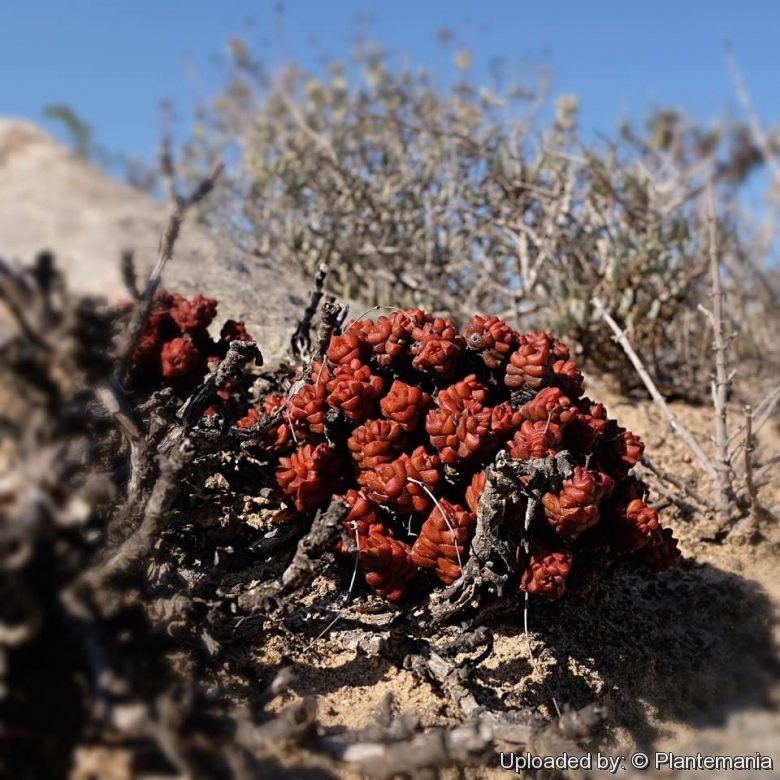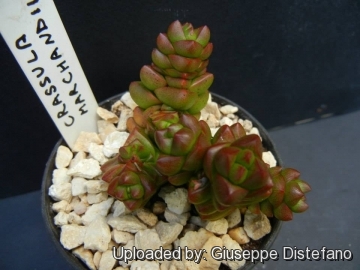
Crassula х marchandii Photo by: © Plantemania
In habitat, Republic of South Africa.
Origin and Habitat: South Africa (Cape Province: Holgat River, Vanrhynsdorp on South Africa's West Coast.)
Synonyms:
Common Names include:
CHINESE (中文): 寿无限
Description: Crassula x marchandii is a poorly known species that might represent a natural hybrid between the green form of Crassula grisea and Crassula plegmatoides. In "Crassula A Growers Guide" by Gordon Rowley, page 131, is shown a photo of C. x marchandii, between its suggested parents. This hybrid resembles more closely with C. plegmatoides. Toelken suggested it is a natural hybrid, based upon the fact that just single plants (of the putative hybrid) were found within populations of the two species. It is generally lumped under Crassula grisea. This Crassula species was first published in 1974 and named after G. Marchand, in charge of the Crassula collection of Julien Marnier-Lapostolle at Les Cèdres. It was offered under the number ISI 640 as Crassula sp. nov. collected by Mr. Otzen at Knersvlakte, Vanrhynsdorp, (C.S.J. US 42 (2): 83,1970), later named Crassula otzenii Hort.
Habit: It is a nice compact pagoda-like crassula with attractive, shiny green leaves forming characteristic 4-ranked columns, it stays relatively low and clumps readily.
Stems: The internodes are short with the subsequent leaves showing extremely dense packing resulting in compact columns to a height of about 70(-150) mm and 25 mm in diameter
Leaves: Glabrous, compressed 1.5-3 cm long, bright emerald green to dark olive green, shining, readily taking on red-brown accents from direct sunlight.
Flowers: Inconspicuous, greyish-green.
Bibliography: Major references and further lectures
1) Gordon Rowley “Crassula: A Grower's Guide” Cactus & Company, 2003
2) C.S.J. US 42 (2): 83,1970
3) Toelken, H.R. “A revision of the genus Crassula” in southern Africa. Annals of the Bolus Herbarium 8,1-595. 1997
 Crassula х marchandii Photo by: Giuseppe Distefano
Crassula х marchandii Photo by: Giuseppe DistefanoSend a photo of this plant.The gallery now contains thousands of pictures, however it is possible to do even more. We are, of course, seeking photos of species not yet shown in the gallery but not only that, we are also looking for better pictures than those already present.
Read More... Cultivation and Propagation: Crassula x marchandii are of easy cultivation and relatively low maintenance, which makes them a good houseplant, and can be an excellent subject for the beginning succulentophile (they can grow easily on window sills, verandas and in miniature succulent gardens where they are happy to share their habitat with other smaller succulent plants, or in outdoor rockeries).
Soil: They prefer a very porous potting mix to increase drainage. You can grow a plant in a 6-10 cm pot for years and have perfectly happy plants. For best results, use a shallow pot.
Watering: Provide some water all year around, in the wild most of the growth occurs during spring and autumn. During the hot summer months, the soil should be kept moist but not overly wet. During the winter months, water only when the soil becomes completely dry. Wet soil quickly causes root and stem rot, especially during chilly winter months, but can re-root if taken care of. No water should ever be allowed to stand around the roots. Low ambient humidity is always needed.
Fertilization: The plants are fertilized only once during the growing season with a balanced fertilizer diluted to ½ the recommended strength.
Sun Exposure: They need full sun or bright, filtered light with ample airflow to stay compact, but avoid direct blasting sun in mid summer (with sun exposure the leaf develops a nice brownish tint), they do not do well in full shade as they tend to etiolate, fall over and rot easily.
Pest & diseases: Crassulas are sensitive to mealybugs.
Rot: Rot is only a minor problem with Crassula if the plants are watered and “aired” correctly. If they are not, fungicides won't help all that much. Care must be given in watering, keeping them warm and wet while growing, and cooler and dry when dormant.
Hardiness: Although the plants will survive mild frost if kept dry (hardy as low as -5° C) they should be protected from frost to prevent scarring. USDA 9b-12
Use: It is an excellent potted plant great for windowsill culture as well as in rock gardens. Indoors only in brightest position.
Pruning: Remove dead flower spikes only.
Propagation: They are easily propagated by the removal of off shoots, remove a lateral shoot and insert the basal part buried in the soil. This shoot should root within a month, and small offshootd will form at the base. They can also be grown from seed.











